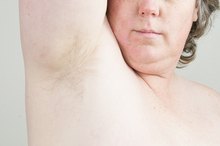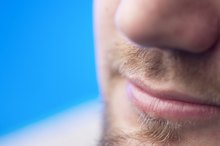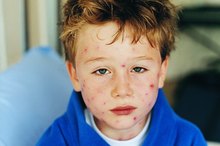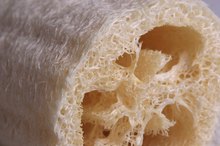How to Get Rid of Ingrown Hairs on Arms
Small, fine bumps on the backs of your arms may indicate the presence of ingrown hairs. Several things cause the appearance of ingrown hairs on your body. Shaving commonly causes ingrown hairs on legs, faces and under arms. Areas of skin that rub against rough fabrics, such as the backs of the arms, can develop ingrown hairs as a result of the constant chafing of the fabric over the emerging hairs. Many people experience an increase in ingrown hairs along their arms during the dry, winter months when long sleeves and rough fabrics create friction against the skin.
Wash your arms to cleanse the area and reduce the chances of infection. The Mayo Clinic suggests washing affected areas with a soft-bristled toothbrush. Use a mild cleanser. Wash gently in a circular motion. Rinse well with water and pat dry.
- Wash your arms to cleanse the area and reduce the chances of infection.
How to Remove Ingrown Arm Hair
Learn More
Remove individual ingrown hairs if you can see them easily beneath the surface of your skin. Wash your skin. Disinfect a fine-tipped needle by dipping it in rubbing alcohol. Insert the tip of the needle under the visible loop of hair and lift upward to pull the coiled length out from under the skin. Lightly rub a cotton swab soaked in rubbing alcohol over the area after removing the ingrown hair.
- Remove individual ingrown hairs if you can see them easily beneath the surface of your skin.
- Lightly rub a cotton swab soaked in rubbing alcohol over the area after removing the ingrown hair.
Apply an exfoliating substance to the affected areas on your arms. The "Gale Encyclopedia of Alternative Medicine" recommends using a cream or gel that contains alpha-hydroxy acids once or twice a day to exfoliate the skin. Products containing this ingredient slough away dead skin and promote collagen growth. Use this cream once or twice a day, according to the package instructions, to promote smoother skin and reduce the appearance of ingrown hairs.
- Apply an exfoliating substance to the affected areas on your arms.
- Use this cream once or twice a day, according to the package instructions, to promote smoother skin and reduce the appearance of ingrown hairs.
How to Get Rid of Blackheads Under Arms
Learn More
Reduce the incidence of ingrown hairs by wearing only soft, smooth fabrics against your skin. Layer a soft cotton or silk undershirt beneath rough sweaters, such as those made from wool, to reduce the friction of these fabrics against your arms. Expose your arms to air and sunlight whenever you can to minimize chafing.
Warnings
Consult your physician if your ingrown hairs become infected. Pinching, squeezing and scratching can increase the risk of infection near the follicles. If you notice swelling, redness or pus in the area of your ingrown hairs, you may have developed a bacterial infection.
Related Articles
References
- Mayo Clinic: Ingrown Hair
- "The Gale Encyclopedia of Alternative Medicine;" Jacqueline L. Longe, 2005
- Ingrown Hair Facts: Ingrown Hair Treatment
- MedlinePlus. Acne.
- Cleveland Clinic. Ingrown hair. Updated February 28, 2018.
- Merck Manuals. Ingrown beard hairs. Updated October 2019.
- Cleveland Clinic. Ingrown hair: Management and treatment. Updated February 28, 2018.
- Ogunbiyi A. Pseudofolliculitis barbae; current treatment options. Clin Cosmet Investig Dermatol. 2019;12:241-247. doi:10.2147/CCID.S149250
- MedlinePlus. Folliculitis. Updated October 8, 2018.
- Zaenglein AL, Pathy AL, Schlosser BJ, Alikhan A, Baldwin HE, et. al. Guidelines of care for the management of acne vulgaris. Journal of the American Academy of Dermatology. 2016; 74(5): 945-73. doi:10.1016/j.jaad.2015.12.037
Writer Bio
Laura Wallace Henderson, a professional freelance writer, began writing in 1989. Her articles appear online at Biz Mojo, Walden University and various other websites. She has served as the co-editor for "Kansas Women: Focus on Health." She continues to empower and encourage women everywhere by promoting health, career growth and business management skills.









